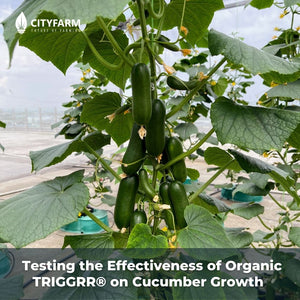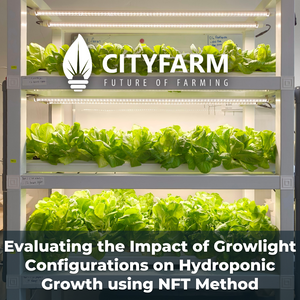[Research] Effects of Dissolved Oxygen (DO) on the Growth of Lollo Rossa in NFT Hydroponic System
![[Research] Effects of Dissolved Oxygen (DO) on the Growth of Lollo Rossa in NFT Hydroponic System](http://cityfarm.my/cdn/shop/articles/11_1024x.png?v=1625561065)
The Effect of Dissolved Oxygen on the Growth of Lollo Rossa in Nutrient Film Technique (NFT) Hydroponic System
Objectives:
- To study the effect of dissolved oxygen on the growth of Lollo Rossa (red coral lettuce).
- To examine the level of dissolved oxygen in nutrient solution with and without aeration system.
Introduction:
Materials:
Methods:


Results:
|
Tank |
Average experimental conditions |
|||
|
EC (mS/cm) |
pH |
DO (mg/L) |
Temperature (℃) |
|
|
Oxygenated |
1.52 |
6.4 |
7.3 |
27.6 |
|
Control |
1.45 |
6.4 |
4.8 |
28.2 |
Table 2.0: Final root and shoot mass of Lollo Rossa samples
|
Sample |
Oxygenated tank |
Control tank |
||
|
Root mass (g) |
Shoot mass (g) |
Root mass (g) |
Shoot mass (g) |
|
|
1 |
27 |
69 |
23 |
67 |
|
2 |
29 |
90 |
24 |
56 |
|
3 |
35 |
114 |
30 |
80 |
|
4 |
32 |
101 |
30 |
90 |
|
5 |
30 |
109 |
29 |
83 |
|
6 |
32 |
118 |
32 |
103 |
|
7 |
34 |
113 |
28 |
80 |
|
8 |
27 |
71 |
28 |
74 |
|
Average mass |
30.8 |
98.1 |
28.0 |
79.1 |
Note: Both root and shoot mass of samples included the net pot and water content in the sponge.
Table 3.0: Independent sample t-test results of the samples’ final root mass
|
Group |
n |
Mean |
SD |
df |
tcal |
t0.05 |
Result |
|
Oxygenated |
8 |
30.75 |
3.012 |
14 |
1.808 |
1.761 |
Accept |
|
Control |
8 |
28.00 |
3.071 |
14 |
Note: The alternative hypothesis specifies that the final root mass of oxygenated group is greater than control group. (Significance level, α = 0.05)
*n = Number of samples; SD = Standard deviation; df = Degree of freedom
Table 4.0: Independent sample t-test results of the samples’ final shoot mass
|
Group |
n |
Mean |
SD |
df |
tcal |
t0.05 |
Result |
|
Oxygenated |
8 |
98.13 |
19.44 |
14 |
2.232 |
1.761 |
Accept |
|
Control |
8 |
79.13 |
14.21 |
14 |
Note: The alternative hypothesis specifies that the final shoot mass of oxygenated group is greater than control group. (Significance level, α = 0.05)
*n = Number of samples; SD = Standard deviation; df = Degree of freedom

Figure 3.0: Final shoot mass and root mass of Lollo Rossa samples.
The (a) shoot and (b) root mass of Lollo Rossa samples collected from oxygenated nutrient tank were greater than (c) shoot and (d) root mass samples from the control.

Figure 4.0: Effect of DO on the growth of Lollo Rossa samples grown in oxygenated and control nutrient tank.
(a) The DO levels in oxygenated nutrient tank (blue line) was practically constant at 7.4 mg/L, whereas the DO levels in control nutrient tank (orange line) remained constant at 4.8 mg/L. The (b) average of plant fresh weight, (c) plant height and (d) leaf number of Lollo Rossa samples grown in oxygenated and control nutrient tank throughout the experimental period.
Notes:
1 The fresh weight of samples has included the net pots and water content in the sponge.
2 The height of samples was measured from the base of net pot up to the tip of leaf.
Discussion:
Dissolved oxygen is simply the presence of free oxygen (O2) molecules dissolved in water and is a critical parameter to be optimized in assessing water quality as it indirectly influences any organisms living by the water. Likewise, in horticulture, DO plays important roles in enhancing both plant quality and crop yields. There are two factors which are temperature and salinity greatly influence the DO content in hydroponic system. Between these two factors, DO content is very temperature-dependent as the temperature inversely regulating the solubility of oxygen in water. Generally speaking, cold water can hold more dissolved oxygen than warm water and vice versa (Becker, 2016).
Based on Table 1.0, although the average temperature of the oxygenated nutrient tank is 0.6 ℃ lower than the control nutrient tank, there is a significant difference in the DO level whereby the oxygenated nutrient tank is 2.5 mg/L higher than the control. Due to the presence of air stones and surface agitation in oxygenated nutrient tank, air bubbles were produced and dispersed evenly in the tank, causing a higher rate of gas exchange at water interface and a higher concentration of DO. In term of the average EC value of nutrient solution, oxygenated nutrient tank demonstrated a higher EC value than the control in the end of the experiment as the plants grown in oxygenated nutrient tank had higher transpiration rate than nutrient uptake rate.
Additionally, based upon Table 2.0, Lollo Rossa samples grown in oxygenated nutrient tank had greater average root and shoot mass in compared with the control. By conducting pooled t-test, the results had revealed that both final root and shoot mass of samples grown in oxygenated nutrient tank were significantly greater than the control samples (Table 3 and Table 4). As proof, Suyantohadi, Kyoren, Hariadi, Purnomo, and Morimoto (2010) also elucidated that DO had positively impacted on both plant and root development in which plants grown in nutrient tank with saturated DO displayed better root and shoot characteristics. Besides, as illustrated in Figure 3.0, samples grown in oxygenated nutrient tank were compact and good in shape. Also, the overall root mass of samples grown in oxygenated nutrient tank was visibly denser and longer than the control samples. Thus, high levels of DO largely not only promote healthy root formation but foster plant development process, producing substantial and healthier plants.
Apart from that, Figure 4.0 shown the different effect of DO on plant fresh weight, height and number of leaves. In respect of plant fresh weight, samples harvested from oxygenated nutrient tank had greater weight, as well as the number of leaves was greater than the control samples. As to the average plant height, the control samples were slightly elongated and higher than the samples treated with high DO level. The stem elongation of control samples was likely correlated with high temperature. On account of the exposure to higher temperature, the occurrence of stem elongation in lettuce was facilitated, resulting in loose leaf structure which can be observed in the control samples (Iqbal, 2018). Therefore, temperature can inversely regulate the solubility of oxygen in water and indirectly affect the morphology of plant.
Conclusion:
To conclude, Lollo Rossa samples grown in oxygenated nutrient tank had significantly final root and shoot mass than the control samples. Over and above, the presence of DO has also proven to improve both plant growth development and characteristics with respect to fresh weight, height and leaf number. More importantly, DO is temperature-dependent and serves as a basic measurement to be taken in consideration for horticulture, optimizing both root and plant development. In the future, an extensive amount of research is required to intensify the understanding of the mechanism involving DO levels against both root and plant development.
References
Becker, K. (2016). Understanding dissolved oxygen. Retrieved from
https://www.growertalks.com/Article/?articleid=22058
Iqbal, Q. (2018). Effect of high temperature and exposure duration on stem elongation of iceberg lettuce. Pakistan Journal of Agricultural Sciences, 55, 95-101. doi:10.21162/PAKJAS/18.6554
Kubota, C. (2020). Chapter 13 - Growth, development, transpiration, and translocation as affected by abiotic environmental factors. In T. Kozai, G. Niu, & M. Takagaki (Eds.), Plant Factory (Second Edition) (pp. 207-220): Academic Press.
Suyantohadi, A., Kyoren, T., Hariadi, M., Purnomo, M. H., & Morimoto, T. (2010). Effect of high consentrated dissolved oxygen on the plant growth in a deep hydroponic culture under a low temperature. IFAC Proceedings Volumes, 43(26), 251-255. doi:https://doi.org/10.3182/20101206-3-JP-3009.00044
- Clara Pang (International University of Malaya-Wales)



![[Research] The Effect of Synthetic Fertilizer and Organic Fertilizer on Plant Growth (Green ribbon)](http://cityfarm.my/cdn/shop/articles/11_69_300x.png?v=1696511389)
![[ArtIcle] Urban Farming: Opportunities and Challenges](http://cityfarm.my/cdn/shop/articles/WhatsApp_Image_2023-05-18_at_14.53.55_300x.jpg?v=1684392966)
![[Article] The Future of Indoor Vertical Farming](http://cityfarm.my/cdn/shop/articles/11_ce4d60df-c15d-4168-9051-811d2f2db016_300x.png?v=1670699733)
![[Research] The Effect of Water Temperature on Plant Growth](http://cityfarm.my/cdn/shop/articles/11_43_300x.png?v=1653919657)